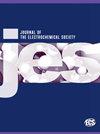基于多孔电极理论的增强型电化学模型,用于更高保真建模和解密 EIS 光谱
IF 3.3
4区 工程技术
Q2 ELECTROCHEMISTRY
引用次数: 0
摘要
电化学阻抗光谱(EIS)对于非侵入式电池特性分析至关重要。本文探讨了如何充分解释 EIS 光谱的难题,因为在相似的时间尺度上发生的重叠内部现象通常会使 EIS 光谱变得复杂。我们首次提出了一种高保真数值时域电化学模型,该模型可以几乎复制实验 EIS 光谱,其中包括三个叠加的高频半圆、虚值升高时向扩散尾部的过渡以及低频时倾斜的扩散尾部。这些先进特性是通过扩展最先进的多孔电极模型实现的,该模型具有创新的子模型,可用于模拟炭黑/电解质和金属锂阳极/电解质界面的双层现象,以及带电物种通过锂阳极界面上的固体电解质相间层的传输现象。此外,我们还通过引入不同尺寸的代表性活性颗粒来模拟扩散尾部的倾斜度。定制半电池的结果证实,与现有模型相比,该模型能够更准确地解读 EIS 光谱。此外,基于物理学的创新电池模型能够准确模拟电池内部现象,利用测量的 EIS 光谱揭示电池的内部状态和物理参数。因此,该模型还能实现先进虚拟传感器的功能,而这正是下一代电池管理系统的重要诊断功能。本文章由计算机程序翻译,如有差异,请以英文原文为准。
Enhanced Porous Electrode Theory Based Electrochemical Model for Higher Fidelity Modelling and Deciphering of the EIS Spectra
Electrochemical impedance spectroscopy (EIS) is essential for non-invasive battery characterization. This paper addresses the challenge of adequate interpretation of EIS spectra, which are often complicated by overlapping internal phenomena occurring on similar time scales. We present, for the first time, a high-fidelity numerical time-domain electrochemical model that can virtually replicate experimental EIS spectra with three superimposed high-frequency semicircles, a transition to the diffusion tail at elevated imaginary values, and a tilted diffusion tail at low frequencies. These advanced features were made possible by extending state-of-the-art porous electrode model with innovative sub-models for the double layer phenomenon at the carbon black/electrolyte and metal Li-anode/electrolyte interfaces, and transport phenomena of charged species through the solid electrolyte interphase at the Li-anode interface. Additionally, we modelled the diffusion tail inclination by introducing representative active particles of varying sizes. Results from custom-made half-cells confirm the model’s ability to decipher EIS spectra more accurately compared to existing models. Moreover, innovative physics-based battery model that is capable of accurately modelling intra-cell phenomena can reveal internal states and physical parameters of batteries using measured EIS spectra. The model, therefore, also enables functionality of an advanced virtual sensor, which is an important diagnostics feature in next-generation battery management systems.
求助全文
通过发布文献求助,成功后即可免费获取论文全文。
去求助
来源期刊
CiteScore
7.20
自引率
12.80%
发文量
1369
审稿时长
1.5 months
期刊介绍:
The Journal of The Electrochemical Society (JES) is the leader in the field of solid-state and electrochemical science and technology. This peer-reviewed journal publishes an average of 450 pages of 70 articles each month. Articles are posted online, with a monthly paper edition following electronic publication. The ECS membership benefits package includes access to the electronic edition of this journal.

 求助内容:
求助内容: 应助结果提醒方式:
应助结果提醒方式:


